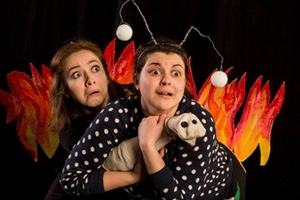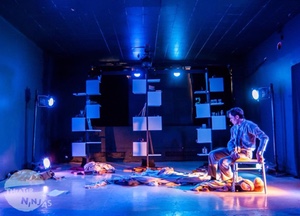
One of the arguments some people have used against the Cuyahoga Arts & Culture Levy (CAC), which is up for renewal November 3 as Issue 8, is that it takes money from the poor (smokers) for the benefit of pastimes enjoyed predominantly by those with more money.
In fact, the levy allows even big arts institutions like the Cleveland Orchestra and the Cleveland Museum of Art to provide low or no-cost programs for the less affluent. But its impact is demonstrated most vividly in the flourishing of tiny arts groups and projects that otherwise might be struggling to survive or might not exist at all, creating a more diverse, well-rounded and accessible arts scene.
One such example is Theatre Ninjas, founded in 2006 by then-recent college graduate Jeremy Paul. He returned to his hometown after graduating from Wesleyan University in Connecticut, spent a year working with various theater organizations around town and hatched the idea for the nomadic troupe, which refers to itself as “the food truck of Cleveland theater.”
The theater has received four CAC project grants and has just applied for a fifth. The first, in 2009, Paul says, “put us on the map for a lot of people.”
It was for a production of Woyzeck that Paul says, “really allowed us to tackle some material that we might normally have strayed away from. We could have an ensemble of actors work for a reasonable period of time. We were able to take time and do justice to the technical elements of the piece. It was a few months after we did Crave, the first show the Plain Dealer reviewed. It was a seminal show for us. With Woyzeck we could double down on ‘This is our aesthetic: we’re doing physical theater in transformed nontraditional spaces’.”
“Every grant we have gotten from CAC has been essential not only as far as getting our aesthetic out into the community but learning new techniques,” he adds. “Each one has been about advancing mission of company. Particularly with a show we did in 2014 called Code, it was the beginning of a process we’re developing called “Prelude,” an approach to devised theater that is iterative and modular. We can take several years to work on it, and work on it in public and do presentations instead of the model where it may take 3 years to do show, but you’re doing it in seclusion. We treat it as a universe we want to inhabit or discover.”
The grants not only allowed Theatre Ninjas to push the pocket and experiment, doing something other theaters weren’t, it made it possible for them to keep ticket prices very low. usually ranging from $10-$20, but with some nights a low as $5.
“We’re not making theater for rich people,” says Paul.
Those things mean attracting a younger audience, building a theater audience and community for the future.

And being a “nomadic” company — one that performs in a variety of “borrowed” spaces, “living out of a messenger bag,” as Paul puts it, means that Theatre Ninjas doesn’t have a lot of overhead costs. Because of that, Paul says most of the grant money they receive goes to pay cast and crew — and they’ve all been paid since the company started.
“We work with a lot of developing artists to learn their craft and provide opportunities for them to sustain here in Cleveland,” he says. “We work with local actors and local designers. We’ve worked with a fair number of local playwrights, local composers, visual artists, multimedia artists.”
Paul was also the personal recipient of one of CPAC’s creative workforce fellowships in 2012, which he used to grow the company as well.
“I spent most of my fellowship year retooling Theatre Ninjas so we could be more consistent and work with more members of theater community,” he says. “At this point we’ve worked with over 100 local artists in last three years since I was a fellow.”
That grant money going to pay local artists of all types circulates in the community, and in the case of an experimental, avant-garde theater like Theatre Ninjas, encourages young, dynamic, creative types to stay in Cleveland. Rather than trying to break into an established institution that might be unwelcoming, they’re in on the ground floor helping to create something new.
“I think it’s not just about supporting a single work or art or supporting a single artist,” says Paul of the arts and culture money. “I think all this arts funding filters back into the community, one-to-one in some cases. As a small company, we’re putting this funding back into the pockets of local artists and local contractors. It’s been an incredibly important program for me personally, and I don’t think there’s a single artist in Cleveland I know that has not been positively impacted by CAC funding.”

.